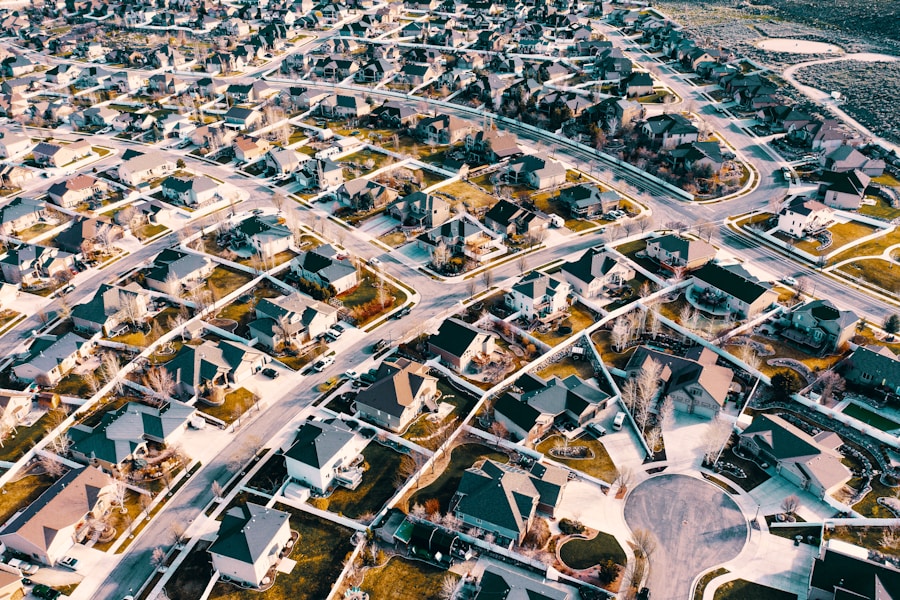The integration of artificial intelligence (AI) into urban planning represents a transformative shift in how cities are designed, developed, and managed. Urban planning has traditionally relied on a combination of historical data, expert judgment, and community input to shape the physical and social landscapes of cities. However, the advent of AI technologies has introduced new methodologies that enhance decision-making processes, optimize resource allocation, and improve the overall quality of urban life.
As cities around the globe grapple with rapid population growth, climate change, and infrastructural challenges, the need for innovative solutions becomes increasingly urgent. AI offers a promising avenue for addressing these complex issues by providing planners with advanced tools for analysis and simulation. AI’s capabilities extend beyond mere data processing; they encompass machine learning algorithms, natural language processing, and computer vision, all of which can be harnessed to create more responsive and adaptive urban environments.
For instance, AI can analyze vast datasets to identify patterns and trends that human planners might overlook. This ability to process and interpret large volumes of information in real-time allows for more informed decision-making and fosters a proactive approach to urban challenges. As cities evolve into smart urban ecosystems, the role of AI in urban planning is poised to become even more critical, shaping the future of how we live, work, and interact within urban spaces.
Key Takeaways
- AI is revolutionizing urban planning by providing advanced tools for predictive modeling, data analysis, and decision-making.
- Predictive modeling plays a crucial role in urban planning by forecasting future trends, identifying potential issues, and optimizing resource allocation.
- Data collection and analysis are essential for predictive modeling in urban planning, and AI technologies enable the processing of large and complex datasets to extract valuable insights.
- AI applications in urban planning include traffic management, infrastructure development, land use optimization, and disaster response planning.
- The benefits of using AI in urban planning include improved efficiency, better decision-making, and enhanced urban resilience, but challenges such as data privacy, bias, and ethical considerations need to be addressed.
The Role of Predictive Modeling in Urban Planning
Predictive modeling serves as a cornerstone of AI applications in urban planning, enabling planners to forecast future scenarios based on historical data and current trends.
These models provide invaluable insights that help planners anticipate challenges and opportunities, allowing for more strategic decision-making.
For example, a city might use predictive modeling to assess the potential impact of a new transportation project on traffic congestion and air quality, thereby informing whether to proceed with the initiative or explore alternative solutions. Moreover, predictive modeling can enhance public engagement in the urban planning process. By visualizing potential outcomes through simulations, planners can present data-driven scenarios to stakeholders, fostering a more transparent dialogue about proposed developments.
This engagement not only helps build community trust but also encourages collaborative problem-solving among residents, businesses, and government entities. As predictive modeling continues to evolve with advancements in AI, its applications in urban planning will likely expand, offering even more sophisticated tools for scenario analysis and decision support.
Data Collection and Analysis for Predictive Modeling

The effectiveness of predictive modeling in urban planning hinges on the quality and breadth of data collected. Urban planners now have access to an unprecedented array of data sources, including satellite imagery, social media activity, sensor networks, and geographic information systems (GIS). These diverse datasets can be integrated to create comprehensive models that reflect the multifaceted nature of urban environments.
For instance, combining traffic data from sensors with demographic information from census data allows planners to understand how different populations interact with transportation systems. Data analysis techniques play a crucial role in transforming raw data into actionable insights. Machine learning algorithms can identify correlations and trends within large datasets that may not be immediately apparent through traditional analytical methods.
For example, clustering algorithms can segment neighborhoods based on socioeconomic factors, enabling planners to tailor interventions that address specific community needs. Additionally, real-time data analysis allows for dynamic modeling that can adapt to changing conditions, such as sudden population influxes or environmental events. This adaptability is essential for creating resilient urban systems capable of responding to both anticipated and unforeseen challenges.
Applications of AI in Urban Planning
AI’s applications in urban planning are diverse and multifaceted, ranging from optimizing land use to enhancing public safety. One prominent application is in transportation planning, where AI algorithms analyze traffic patterns to optimize signal timings and reduce congestion. Cities like Los Angeles have implemented AI-driven traffic management systems that adjust signals in real-time based on current traffic conditions, resulting in smoother traffic flow and reduced travel times.
Another significant application is in land-use planning, where AI can assist in identifying suitable locations for new developments based on various factors such as zoning regulations, environmental impact assessments, and community needs. For instance, AI can analyze historical land-use patterns alongside current demographic trends to recommend areas for affordable housing development or commercial expansion. Furthermore, AI-powered tools can facilitate participatory planning by allowing residents to visualize proposed changes through augmented reality applications or interactive platforms.
AI also plays a critical role in environmental sustainability efforts within urban planning. Machine learning models can predict the impact of urbanization on local ecosystems and help planners design green spaces that mitigate heat islands or improve air quality. Cities like Singapore have embraced AI technologies to monitor biodiversity within urban parks and optimize their maintenance schedules based on usage patterns.
Benefits and Challenges of Using AI in Urban Planning
The benefits of incorporating AI into urban planning are manifold. One of the most significant advantages is the ability to make data-driven decisions that enhance efficiency and effectiveness. By leveraging predictive analytics, planners can allocate resources more strategically, ensuring that investments yield maximum benefits for communities.
Additionally, AI can streamline administrative processes by automating routine tasks such as data entry or report generation, freeing up planners to focus on more complex challenges. However, the integration of AI into urban planning is not without its challenges. One major concern is the potential for bias in algorithms that could lead to inequitable outcomes.
If historical data reflects systemic inequalities—such as racial or socioeconomic disparities—AI models trained on this data may inadvertently perpetuate these biases in decision-making processes. Ensuring fairness and equity in AI-driven planning requires ongoing scrutiny of data sources and algorithmic transparency. Another challenge lies in the technical capacity required for effective implementation.
Many urban planning departments may lack the necessary expertise or resources to adopt advanced AI technologies fully. This gap can hinder the potential benefits of AI integration and exacerbate existing disparities between well-resourced cities and those with limited capabilities. Addressing these challenges necessitates investment in training programs for planners and collaboration between public agencies and technology providers.
Case Studies of Successful AI Implementation in Urban Planning

Several cities around the world have successfully implemented AI technologies in their urban planning processes, showcasing the potential benefits of these innovations. In Barcelona, Spain, the city has adopted an AI-driven platform called “Sentilo,” which collects real-time data from various sensors throughout the city. This platform enables city officials to monitor traffic flow, air quality, and energy consumption while providing valuable insights for future urban development projects.
The integration of this data has led to improved public transportation services and enhanced environmental sustainability initiatives. Another notable example is Singapore’s Smart Nation initiative, which leverages AI to create a more livable urban environment. The city-state employs machine learning algorithms to analyze traffic patterns and optimize public transport routes accordingly.
Additionally, Singapore has implemented an AI-based system for managing its extensive network of green spaces, ensuring that parks are maintained efficiently while promoting biodiversity. These initiatives not only improve residents’ quality of life but also position Singapore as a global leader in smart urban development. In Toronto, Canada, the Sidewalk Labs project aimed to create a smart neighborhood using AI technologies to enhance urban living.
Although the project faced significant public scrutiny and was ultimately canceled due to concerns over privacy and data governance, it highlighted the potential for AI-driven solutions in urban design. The lessons learned from this initiative underscore the importance of community engagement and ethical considerations when implementing AI technologies in urban planning.
Ethical Considerations in AI-Driven Urban Planning
As cities increasingly turn to AI for urban planning solutions, ethical considerations must be at the forefront of discussions surrounding these technologies. One primary concern is data privacy; as planners collect vast amounts of personal information through various channels—such as mobile apps or social media—ensuring that this data is handled responsibly becomes paramount. Urban planners must establish clear guidelines for data usage that prioritize individual privacy while still enabling effective analysis.
Moreover, transparency in algorithmic decision-making is essential for fostering public trust in AI-driven planning processes. Stakeholders should have access to information about how algorithms function and the criteria used for decision-making. This transparency helps mitigate concerns about bias or discrimination while empowering communities to engage meaningfully with planning initiatives.
Additionally, there is a need for inclusive practices that ensure diverse voices are represented in the planning process. Engaging marginalized communities in discussions about AI applications can help identify potential biases or unintended consequences early on. By prioritizing equity and inclusivity in AI-driven urban planning efforts, cities can work towards creating environments that serve all residents fairly.
The Future of AI in Urban Planning
Looking ahead, the future of AI in urban planning appears promising yet complex. As technology continues to advance at an unprecedented pace, cities will likely adopt increasingly sophisticated AI tools that enhance their ability to respond to dynamic challenges. The integration of AI with other emerging technologies—such as blockchain for secure data sharing or Internet of Things (IoT) devices for real-time monitoring—will further expand the possibilities for smart urban development.
However, realizing this potential will require ongoing collaboration between technologists, urban planners, policymakers, and communities. Establishing frameworks for ethical governance will be crucial in ensuring that AI technologies are deployed responsibly and equitably across diverse urban contexts. As cities navigate this evolving landscape, they must remain vigilant about addressing issues related to bias, privacy, and inclusivity.
Ultimately, the successful integration of AI into urban planning will depend on a shared vision among stakeholders committed to creating sustainable and livable cities for future generations. By harnessing the power of AI while prioritizing ethical considerations and community engagement, urban planners can pave the way for innovative solutions that enhance quality of life in an increasingly complex world.
AI technology is revolutionizing various industries, including urban planning. Predictive modeling is a powerful tool that can help city planners make informed decisions about infrastructure development and resource allocation. One related article that delves into the world of technology is Samsung Smartwatches Review. This article explores the latest advancements in wearable technology and how they are impacting our daily lives. Just as AI is transforming urban planning, smartwatches are changing the way we interact with technology on a personal level.
FAQs
What is urban planning?
Urban planning is the process of designing and shaping the physical layout of cities, towns, and communities. It involves making decisions about the use of land, infrastructure, transportation, and public spaces to create sustainable, functional, and aesthetically pleasing environments.
How is AI being used in urban planning?
AI is being used in urban planning through predictive modeling, which involves using algorithms and data analysis to forecast future trends and outcomes related to population growth, transportation needs, infrastructure development, and environmental impact.
What are the benefits of using AI in urban planning?
Using AI in urban planning can help city officials and planners make more informed decisions by providing insights into potential future scenarios. It can also help optimize resource allocation, improve efficiency, and enhance the overall sustainability and livability of urban areas.
What types of data are used in AI-supported urban planning?
AI-supported urban planning relies on a wide range of data sources, including demographic information, land use patterns, transportation data, environmental data, economic indicators, and historical trends. This data is used to train predictive models and make informed projections about future urban development.
Are there any challenges or limitations to using AI in urban planning?
Challenges and limitations to using AI in urban planning include the need for high-quality, reliable data, potential biases in the algorithms, and the complexity of integrating AI systems into existing planning processes. Additionally, there may be concerns about privacy and data security when using sensitive information for predictive modeling.

